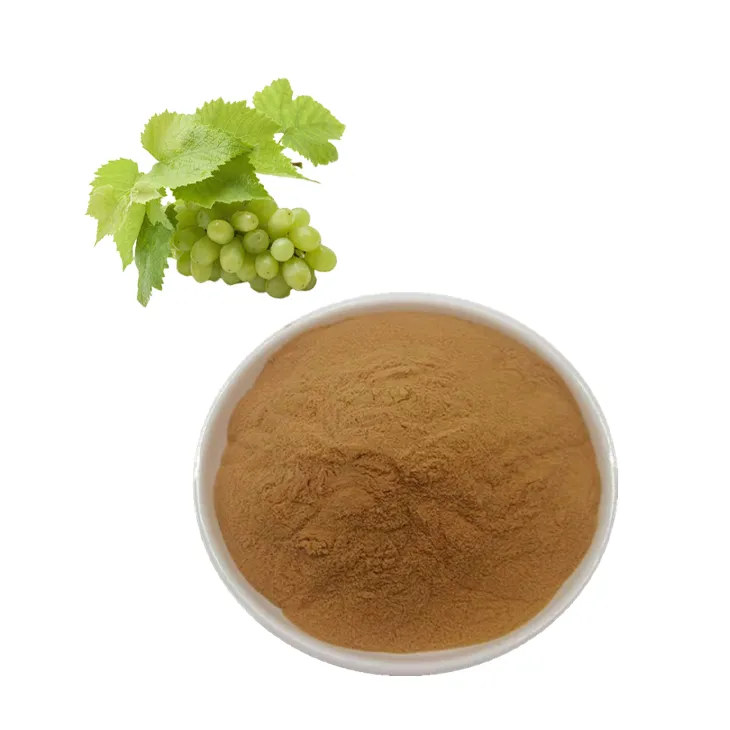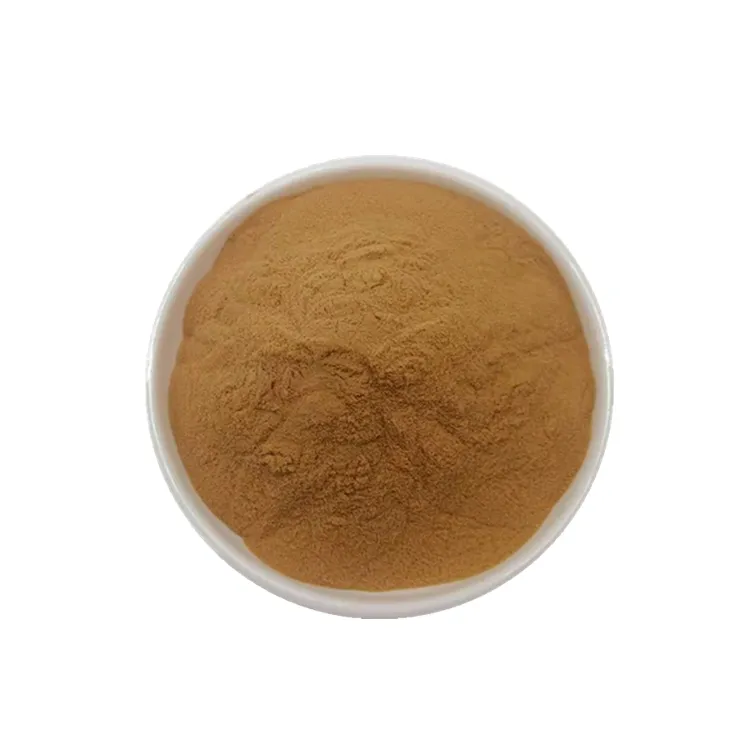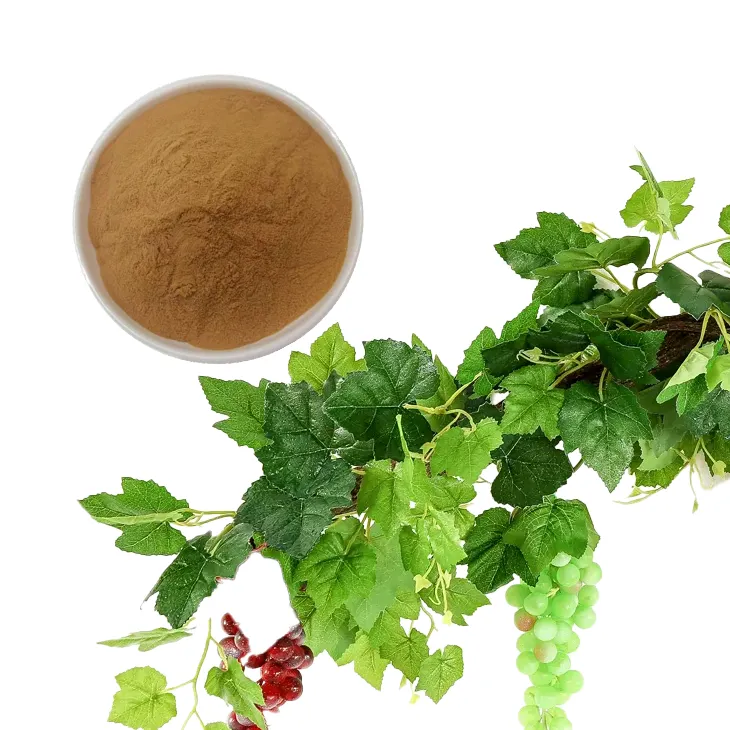- 0086-571-85302990
- sales@greenskybio.com
How to Extract Grape Leaf Extract from Plants.
2024-11-26

1. Introduction
Grape Leaf Extract has gained significant attention in various fields such as medicine, cosmetics, and food industries. It is rich in polyphenols, flavonoids, and other bioactive compounds that possess antioxidant, anti - inflammatory, and antimicrobial properties. The extraction process is crucial to obtain a high - quality extract with maximum bioactivity. In this article, we will explore in detail how to extract Grape Leaf Extract from plants.

2. Plant Material Preparation
2.1 Collection of Grape Leaves
The first step in obtaining Grape Leaf Extract is to collect fresh and healthy grape leaves. It is important to choose the right time for collection. Generally, the leaves should be collected during the growing season when they are rich in bioactive compounds. For example, in the case of Vitis vinifera, the leaves are often collected in mid - to - late summer.When collecting, avoid leaves that are damaged by pests or diseases, as they may contain lower levels of the desired compounds or may introduce contaminants into the extract.
2.2 Cleaning of Grape Leaves
Once the grape leaves are collected, they need to be thoroughly cleaned. This cleaning process is essential to remove dirt, dust, and any other foreign particles. The leaves can be washed gently under running water. It is advisable to use mild detergents sparingly if necessary, but make sure to rinse the leaves thoroughly to remove any detergent residue.After washing, the leaves can be patted dry with a clean towel or allowed to air - dry in a clean and well - ventilated area.
2.3 Drying of Grape Leaves
Drying the grape leaves is an important step before extraction. There are different methods of drying, such as air - drying, oven - drying, and freeze - drying.- Air - drying: This is the simplest and most cost - effective method. The cleaned leaves are spread out in a single layer on a clean, dry surface in a well - ventilated area. However, air - drying may take a relatively long time, and there is a risk of microbial growth during the drying process if the humidity is high.
- Oven - drying: This method is faster than air - drying. The leaves are placed in an oven at a low temperature (usually around 40 - 50°C). Oven - drying helps to reduce the moisture content quickly, but care must be taken not to overheat the leaves as this may lead to the degradation of bioactive compounds.
- Freeze - drying: Although more expensive, freeze - drying is considered the best method for preserving the bioactivity of the compounds in the grape leaves. In this process, the leaves are first frozen and then the water is removed by sublimation under vacuum. This method minimizes the degradation of heat - sensitive compounds.

3. Extraction Methods
3.1 Maceration
Maceration is one of the most common and traditional methods for extracting grape leaf extract.- First, the dried grape leaves are ground into a fine powder. This increases the surface area of the plant material, allowing for better extraction of the compounds. The powder can be obtained using a mortar and pestle or a mechanical grinder.
- Then, a suitable solvent is selected. Commonly used solvents for maceration include ethanol, methanol, and water. Ethanol is often preferred as it can dissolve a wide range of bioactive compounds and is relatively safe for use. The ratio of the solvent to the plant material (grape leaf powder) is also important. A typical ratio could be 1:10 (plant material:solvent) by weight, but this can be adjusted depending on the specific requirements.
- The ground grape leaf powder is then soaked in the solvent in a sealed container. The container is placed in a dark and cool place for a certain period, usually several days to a few weeks. During this time, the solvent penetrates the plant material and extracts the bioactive compounds through diffusion.
- After the maceration period, the mixture is filtered to separate the liquid extract from the solid plant residue. Filtration can be done using filter paper in a Buchner funnel or other filtration devices.
3.2 Ultrasonic - Assisted Extraction
Ultrasonic - assisted extraction is a more modern and efficient method for obtaining grape leaf extract.- The dried and ground grape leaf powder is placed in a suitable container with the selected solvent, similar to the maceration process. However, in this case, an ultrasonic bath or probe is used.
- The ultrasonic waves are applied to the mixture. The ultrasonic energy creates cavitation bubbles in the solvent. When these bubbles collapse, they generate high - pressure and high - temperature micro - environments, which enhance the mass transfer of the bioactive compounds from the plant material into the solvent. This results in a faster and more efficient extraction compared to traditional maceration.
- The extraction time using ultrasonic - assisted extraction is usually shorter than maceration. It can range from a few minutes to a couple of hours, depending on the power of the ultrasonic device and the nature of the plant material and solvent.
- After the extraction, the mixture is filtered in the same way as in maceration to obtain the liquid extract.

4. Post - Extraction Treatment
4.1 Separation of Impurities
After obtaining the liquid extract through either maceration or ultrasonic - assisted extraction, it usually contains impurities such as small plant particles, waxes, and other non - target compounds. These impurities need to be removed to obtain a pure grape leaf extract.- Filtration can be further repeated using finer filter papers or membrane filters to remove smaller particles. Membrane filters with different pore sizes can be selected depending on the size of the impurities to be removed.
- Centrifugation can also be used. The extract is placed in a centrifuge tube and spun at a high speed. This causes the heavier particles to sediment at the bottom of the tube, and the supernatant, which is the relatively pure extract, can be carefully decanted.
4.2 Concentration of the Extract
In some cases, it may be necessary to concentrate the grape leaf extract to increase the concentration of bioactive compounds. There are several methods for concentration.- Evaporation under reduced pressure is a common method. The extract is placed in a rotary evaporator, and the solvent is evaporated off at a low temperature under vacuum. This helps to preserve the bioactivity of the compounds while concentrating the extract.
- Freeze - drying can also be used for concentration. After freeze - drying, the resulting solid can be re - dissolved in a smaller volume of solvent to obtain a more concentrated extract.
5. Quality Control and Characterization
5.1 Determination of Bioactive Compounds
To ensure the quality of the grape leaf extract, it is necessary to determine the content of bioactive compounds such as polyphenols and flavonoids. Spectroscopic methods such as UV - Vis spectroscopy can be used to estimate the total phenolic content. High - performance liquid chromatography (HPLC) is a more accurate method for identifying and quantifying individual phenolic and flavonoid compounds.By comparing the results with standard reference materials, the quality and potency of the extract can be evaluated.
5.2 Antioxidant Activity Assay
The antioxidant activity of the grape leaf extract is one of its important properties. There are several methods to assay antioxidant activity.- The DPPH (2, 2 - diphenyl - 1 - picrylhydrazyl) free radical scavenging assay is a commonly used method. The extract is mixed with DPPH solution, and the decrease in the absorbance of DPPH is measured. A higher decrease in absorbance indicates a higher antioxidant activity.
- The ABTS [2, 2' - azinobis - (3 - ethylbenzothiazoline - 6 - sulfonic acid)] radical cation decolorization assay is another method. It measures the ability of the extract to scavenge ABTS radicals.
6. Conclusion
The extraction of grape leaf extract from plants involves several important steps, starting from plant material preparation, through different extraction methods, and finally post - extraction treatment. Each step needs to be carefully optimized to obtain a high - quality extract with maximum bioactivity. With the increasing demand for natural products with health - promoting properties, the extraction of grape leaf extract has great potential in various industries.
FAQ:
What are the main steps in preparing plant material for grape leaf extract?
The main steps in preparing plant material for grape leaf extract include proper cleaning and drying of the grape leaves. Cleaning helps to remove dirt, debris, and other contaminants from the leaves. Drying is important to reduce the moisture content, which can prevent the growth of microorganisms during the extraction process and also help in better extraction of compounds later.
How does maceration work in extracting grape leaf extract?
In maceration, grape leaves are soaked in a solvent. The solvent penetrates the plant material and dissolves the desired compounds present in the grape leaves. This process is carried out for a certain period, during which the compounds gradually move from the solid plant material (grape leaves) into the solvent. After this, the solvent containing the dissolved compounds can be separated from the remaining plant material for further processing.
What are the advantages of ultrasonic - assisted extraction for grape leaf extract?
The advantages of ultrasonic - assisted extraction for grape leaf extract are mainly related to its ability to enhance extraction efficiency. Ultrasonic waves create cavitation bubbles in the solvent. When these bubbles collapse, they generate intense local forces that can break the cell walls of the grape leaves more effectively. This allows the solvent to access the intracellular compounds more easily, resulting in a faster and more complete extraction of the desired substances compared to traditional extraction methods.
How can impurities be separated from the extracted solution of grape leaf extract?
There are several methods to separate impurities from the extracted solution of grape leaf extract. Filtration is a common method, where a filter medium (such as a filter paper or a membrane) is used to physically block the impurities while allowing the extract - containing solution to pass through. Another method is centrifugation, which uses the principle of centrifugal force to separate heavier impurities from the solution. Additionally, techniques like chromatography can also be used to purify the extract by separating different components based on their chemical properties.
What are the potential uses of pure grape leaf extract?
Pure grape leaf extract has several potential uses. In the field of medicine, it may have antioxidant, anti - inflammatory, or other beneficial pharmacological properties, which could be explored for the development of new drugs or dietary supplements. In the cosmetic industry, it can be used in skincare products due to its potential antioxidant effects on the skin. It may also have applications in the food industry as a natural flavoring agent or a preservative.
Related literature
- The Extraction and Characterization of Bioactive Compounds from Grape Leaves"
- "Optimization of Grape Leaf Extract Extraction Methods for Industrial Applications"
- "Analysis of the Chemical Composition of Grape Leaf Extracts"
- ▶ Hesperidin
- ▶ citrus bioflavonoids
- ▶ plant extract
- ▶ lycopene
- ▶ Diosmin
- ▶ Grape seed extract
- ▶ Sea buckthorn Juice Powder
- ▶ Beetroot powder
- ▶ Hops Extract
- ▶ Artichoke Extract
- ▶ Reishi mushroom extract
- ▶ Astaxanthin
- ▶ Green Tea Extract
- ▶ Curcumin Extract
- ▶ Horse Chestnut Extract
- ▶ Other Problems
- ▶ Boswellia Serrata Extract
- ▶ Resveratrol Extract
- ▶ Marigold Extract
- ▶ Grape Leaf Extract
- ▶ blog3
- ▶ blog4
-
Chinese Withania somnifera Extract Factory.
2024-11-26
-
中国松树皮提取物粉粉末供应商
2024-11-26
-
High - quality Marigold Extract Products.
2024-11-26
-
100% Pure Natural Mango - Flavored Powder.
2024-11-26
-
Pomegranate Extract
2024-11-26
-
Clove Powder
2024-11-26
-
Alisma Extract
2024-11-26
-
Mulberry Extract
2024-11-26
-
Genistein
2024-11-26
-
Saponin Extract
2024-11-26
-
Yohimbine Bark Extract
2024-11-26
-
Europen Bilberry Extract
2024-11-26
-
Purple Sweet Potato Extract
2024-11-26
-
Bayberry Extract
2024-11-26





















